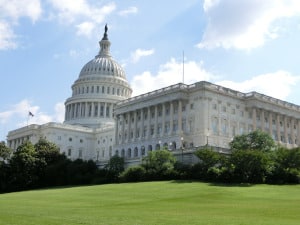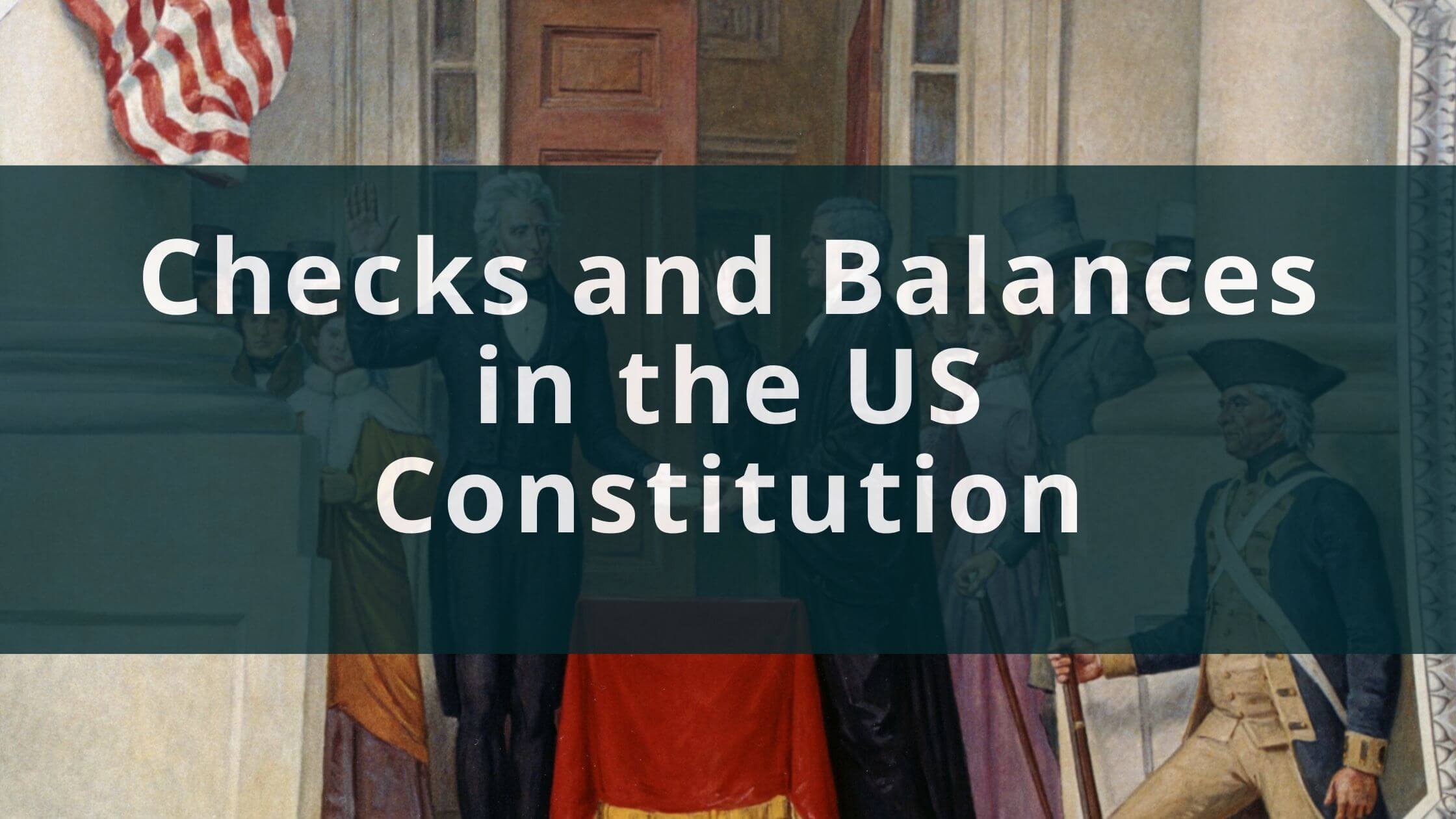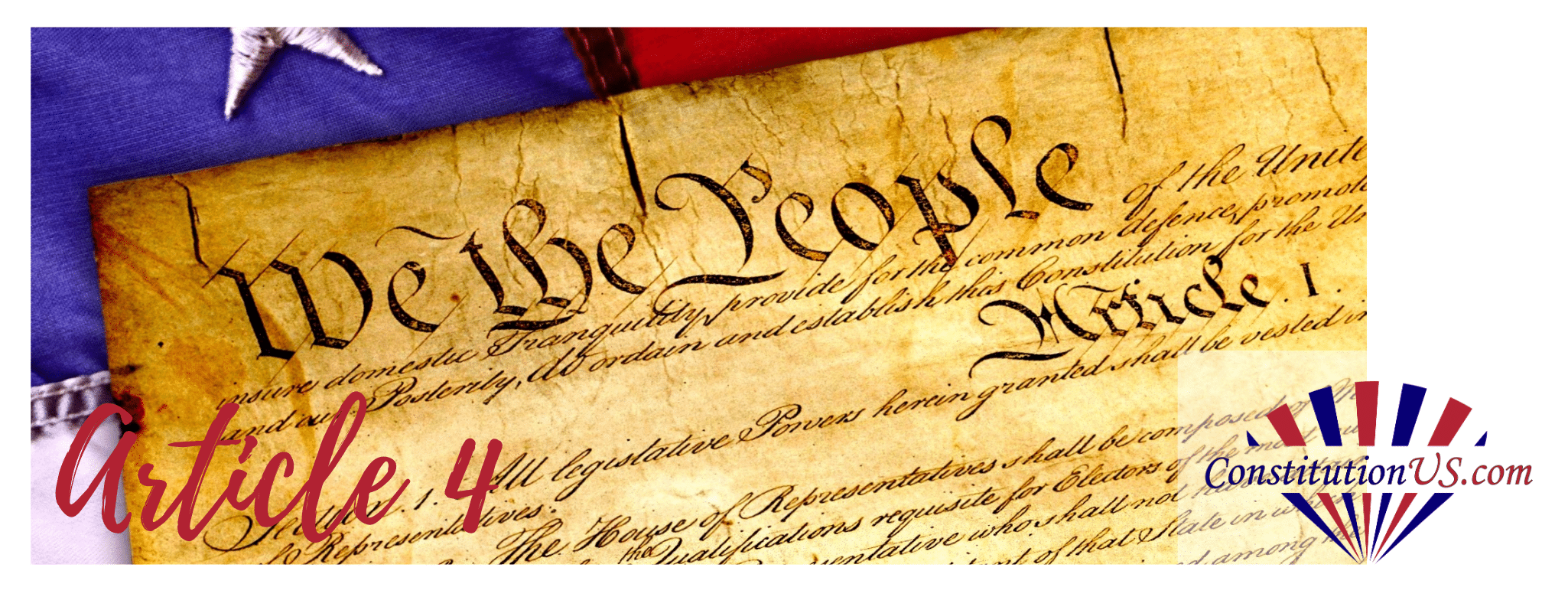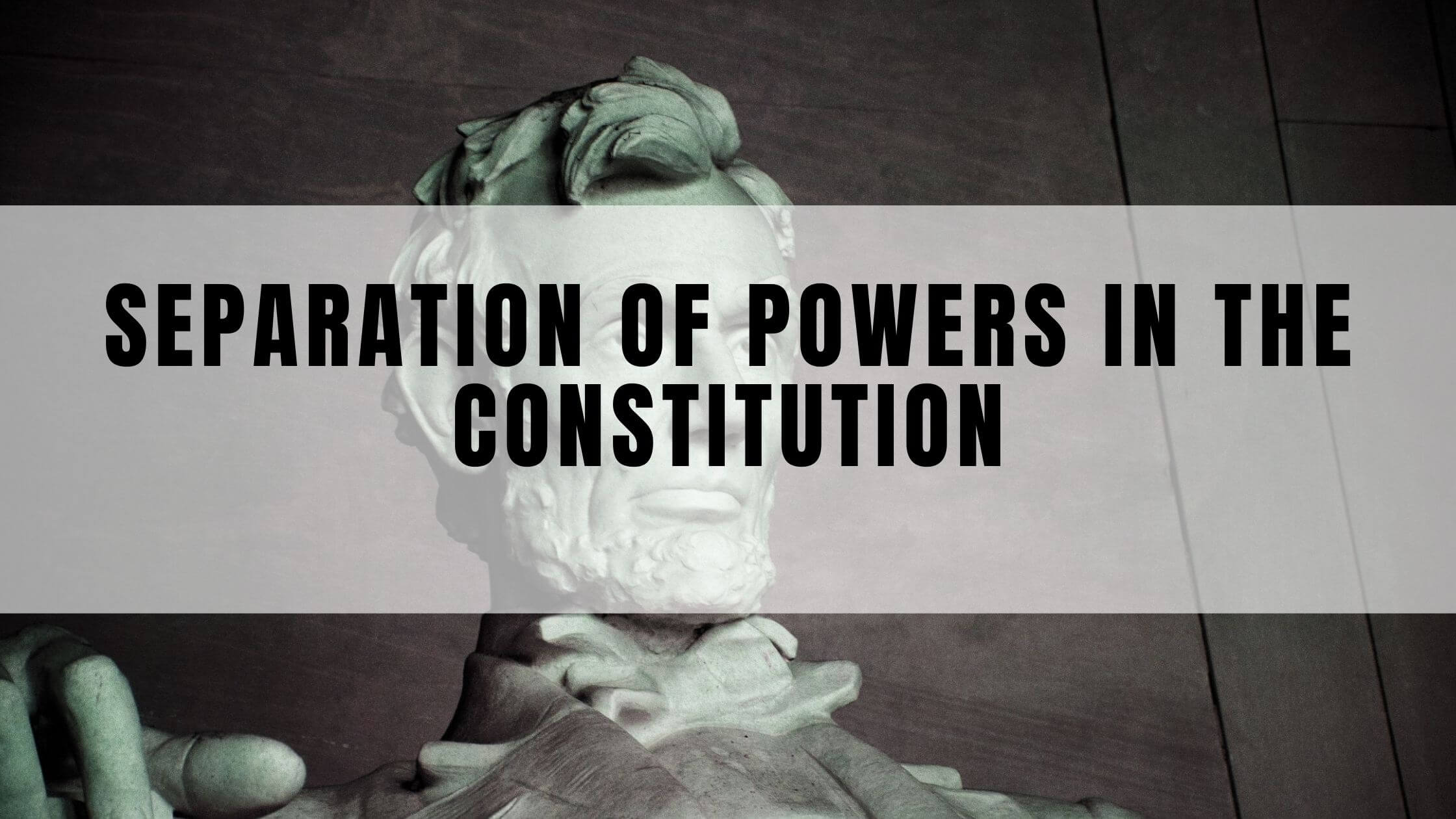Table of Contents
Toggle“Trias Politica“
The US Constitution is a powerful document that breathes into our everyday lives even today. Ensuring that no single branch of government concentrates power unto itself, the US Constitution formally establishes “trias politica” or the Separation of Powers doctrine. By dividing political authority among the three co-equal branches of government, each branch can meaningfully limit the others’ powers and ensure balanced governance.
What checks and balances are suggested or hinted at in the US Constitution?
The US Constitution’s Two-Fold Intent
The framers of the US Constitution focused on limiting government power and ensuring the liberty of citizens. They wanted to avoid a government that copied the powers of the King of England and his parliament.
Striking a balance between authority and individual freedom, the US Constitution organizes the country’s three primary political institutions, defines the relations between states and the privileges of the citizens of the states, stipulates the procedures for amendments, and reiterates its supremacy over all other laws of the land.
Of the seven articles of the main text of the US Constitution, the first three articles establish how the Separation of Powers doctrine works from the outset, with the fourth article hinting at the checks and balance system at work. Essentially, the Constitution assigns the legislative branch to make laws, the executive branch to implement these laws, and the judicial branch to interpret these laws when issues arise.
Legislative Powers
Article I of the US Constitution vests all law-making powers in a Congress made up of the House of Representatives and the Senate. Representation in the House of Representatives is based on the represented states’ population, while each state is entitled to elect two senators in the Senate, with all states equally represented.

Get Smarter on US News, History, and the Constitution
Join the thousands of fellow patriots who rely on our 5-minute newsletter to stay informed on the key events and trends that shaped our nation's past and continue to shape its present.
This bicameral form of the legislature was arrived at after a series of rancorous debates during the framing of the US Constitution in the summer of 1787 in Philadelphia, Pennsylvania. These debates focused on states’ rights, representation, and slavery, among other issues.

In the end, the 55 delegates to the Constitutional Convention adopted a proposal by the Connecticut delegation to form a bicameral structure as a form of settlement to accommodate divergent positions, which is now known as “The Great Compromise.”
Basically, Congress is responsible for enacting the states’ laws and appropriating the funds necessary to operate the government. Specific powers given to Congress are the right to determine member seating and rules of procedure, the powers to impose taxes, borrow money, provide for military forces, regulate interstate commerce, declare war, initiate impeachment proceedings through the House of Representatives, and adjudicate impeachment through the Senate.
Executive Powers
Article II vests executive powers in the Office of the President of the United States. An electoral college selects the President to serve a four-year term with one re-election.
The President is responsible as commander-in-chief of the United States armed forces and has the power to negotiate treaties with other countries, grant pardons, appoint members of his executive cabinet and the federal judiciary.
The executive branch of government is responsible for implementing and administering the public policy enacted and funded by the legislative branch.

Constitutionally, the President’s formal powers are limited compared to those of Congress. Historically, though, the President has assumed more powers, especially during crises and wars.
Technologically, too, mainly through the mass media, the President has been accepted as the symbolic representation of a democratic government and the top official of the land that journalists and the public turn to for national policy and direction matters.
Judicial Powers
Article III vests judicial powers in the US courts. The Constitution is interpreted by the courts, from the lower federal courts to the state courts, to the Supreme Court, the final court of appeal.
The judicial branch is responsible for interpreting the Constitution and laws and applying their interpretations to controversies brought before it.
Although it is not expressly stated in the main text of the US Constitution, the power of American courts to decide on the constitutionality of laws, known as judicial review, was first asserted by Supreme Court Justice John Marshall in Marbury vs. Madison in 1803 and is now recognized all over the country. The judicial review principle grants the federal courts the power to declare executive and legislative acts unconstitutional.
Relations Between States and Their Citizens
Article IV defines the relations between states and the privileges of the citizens of each state, recognizing the authority and relative independence of each state and asserting that these should be subsumed to uphold the individual liberty of citizens among states in interdependence with each other.
The full faith and credit clause provisions, for example, guarantee a republican form of government for each state, require states to recognize the official acts and judicial proceedings of other states, and that each state provides the citizens from other states with all the privileges and immunities each state affords its own citizens.
Constitutional Amendments Reflecting Checks and Balances
After these four articles in the main text of the US Constitution, a number of amendments in the 27 Amendments ratified so far also touch on the Separation of Powers doctrine’s application in the checks and balances system of a tripartite federal government.
The 10th Amendment, for example, states in general terms certain limits to the powers of the federal government. The Supreme Court has used the 10th Amendment several times to nullify many acts of Congress to implement reforms on a national level. During President Franklin D. Roosevelt’s first term, the Supreme Court struck down many important features of the New Deal as unconstitutional.
The 11th Amendment establishes the principle of state sovereign immunity where states are shielded from suits brought by their citizens, citizens of other states, or citizens of foreign countries. It limits federal power as a form of check and balance system since federal courts cannot even exercise jurisdiction over state defendants unless the state consents to jurisdiction.
The 16th Amendment gave Congress the power to lay and collect taxes on all incomes from whatever source derived, without apportionment among the several states and without regard to any census or enumeration. It built up the federal government’s power to enact a modern, nationwide income tax in the 20th century. This income tax is now the federal government’s largest revenue source significantly contributes to the operations of the tripartite federal government.
The 17th Amendment gave the power to elect Senators directly to the people. Previously the power to appoint Senators was through the state legislatures. In effect, it removed state government representation from the federal government’s legislative branch.
The 20th Amendment, also called the “Lame Duck Amendment,” intended to remove the long period of time a defeated President or member of Congress continues to sit in office after their failed re-election bid by indicating the beginning and ending dates of their terms. This also effectively limits their access to power as a form of check and balance and makes the government more responsive to the needs of its constituents.
The 22nd Amendment limits to two terms the President may serve and sets additional eligibility conditions for presidents who succeed to the unexpired terms of their predecessors. This effectively prevents presidents from sitting too long in office and accumulating too much power.

The 25th Amendment, proposed by Congress and ratified by the states after President John F. Kennedy’s assassination, defines presidential succession. This prevents a vacuum in power and ensures the orderly functioning of the executive branch and the federal government as a whole, in the untimely death of a president, their resignation, or their inability to perform their functions as president.
The 27th Amendment prevents members of Congress from giving themselves pay raises during the current congressional session. Instead, any pay raises adopted can take effect only in the subsequent session. This is a form of check and balance using a constitutional and judicial provision to check on legislative members enriching themselves while in session.
Separation of Powers in Action
Here are examples now of how this Separation of Powers doctrine is enacted in the check and balance system of governance among the three branches of government —
- The President can veto any bill passed by Congress, but a two-thirds vote in Congress can also override the veto.
- The House of Representatives has the only power to impeach, but the Senate has all the power to try any impeachment.
- The President has the power to grant all kinds of pardon for any crime against the US, except in an impeachment.
- The President is the commander-in-chief of the US Army and Navy, but it is Congress that has the power to set any taxes or duties to collect revenues to run the government.
- Any bill that attempts to raise revenue must come from the House of Representatives, but the Senate also has to approve the bill for it to become law.
- The President can make treaties with other nations but only after two-thirds concurrence by the Senate.
- The President can appoint Supreme Court judges, but the Senate must approve the President’s choices.
- Supreme Court judges can declare any presidential action as unconstitutional.
- The Vice President automatically becomes the President of the Senate.
- Congress can override a Supreme Court decision by amending the Constitution.
Lately, examples of how this is practiced were evident in the following cases —
- Where President Bill Clinton signed into law the Defense of Marriage Act (DOMA) in 1996, declaring the federal definition of marriage as between a man and a woman, the Supreme Court ruled that same-sex marriage was federally legal in 2015.
- When the House of Representatives brought impeachment charges against President Bill Clinton in 1998, the Senate acquitted him. This happened to President Donald Trump, too, in 2019 and 2021, when the House of Representatives charged him for impeachment, but the Senate ended up acquitting him.
- In 2016, Congress overrode a veto by President Barack Obama over the issue of allowing families of 9/11 victims to sue Saudi Arabia.
U.S. vs. Alvarez particularly highlights the interplay among the three branches of government in action in just one case:
- In 2005, the legislative branch, or Congress, passed the Stolen Valor Act punishing those misrepresenting themselves as having received high military honors.
- In 2012, the judicial branch, through the Supreme Court of the United States, ruled that the Stolen Valor Act of 2005 was unconstitutional because it infringed on the right to free speech protected by the First Amendment.
- Within months of the Supreme Court’s decision, the executive branch, through the office of the President and the Pentagon, established a government-funded national database of medal citations to verify military honors.
- Less than a year after the Alvarez case was decided, the legislative branch, or Congress, responded with legislation seeking to remedy the constitutional problems in the 2005 Act, continuing prohibition on false claims of military honors outside the protection of the First Amendment. This resulted in the Stolen Valor Act of 2013, narrowing the original legislation to more specific conditions.
A Constantly Evolving Tension
Even if the Separation of Powers doctrine is foundational to how the American government works, in practice, no democratic system exists with absolute separation of powers between the three branches, nor an absolute absence of separation of powers.
Each branch’s powers and responsibilities tend to overlap with the others as they are too interrelated and complex to be neatly divided and compartmentalized from each other. In effect, there has always been a built-in degree of competition and conflict between the different branches, resulting in a constantly evolving tension, with cycles of leading prominence among them in the ebbs and flows of national life.
In recent years, though, even with this carefully designed check and balance system in place, it has been put to several tests. Presidents from both political parties have increasingly appropriated the law-making powers traditionally reserved for Congress and the selection process for judges and funding for the courts has become more politicized.
Oversight is still needed, more than ever, and citizens must remain vigilant to ensure that the Constitution’s original intent is still honored. That is, to limit and balance government authority and promote “life, liberty, and the pursuit of happiness” with a healthy functioning checks and balance system in place.












One Response
God Bless each and every one of you Patriots
Thanks for your help!!